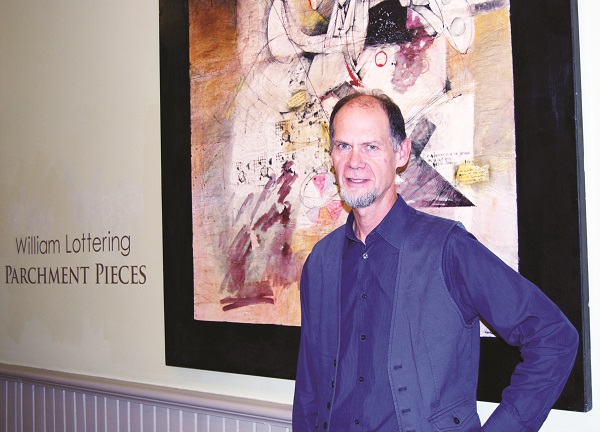Archive
AHS teacher charts journey from Apartheid to Aurora in “Parchment Pieces”
October 1, 2014 · 0 Comments

By Brock Weir
From a very early age, William Lottering found inspiration in what was beneath his feet.
He saw the soil as a record of human activity in the world. It wasn’t just dirt, he saw something beautiful, and he began to incorporate this unique view of the Earth into his art.
But he’s now far removed from the soil on which he grew up that provided this early inspiration and his journey from his youth, to his life here in Canada, where he recently completed his tenure as an art teacher at Aurora High School, is charted in his new exhibition, “Parchment Pieces”, now on in the Great Hall Gallery at the Aurora Cultural Centre.
Mr. Lottering grew up as an Afrikaner, just outside of Johannesberg, South Africa. As a child, he often played in nearby hills and fields with his brother, making simple games out of the natural resources around them. In the height of Apartheid, however, these simple childhood days gave way to something Mr. Lottering describes as much more violent, something he did not want to be a part of, and yet inevitably had a heavy influence on his art.
“I was a new immigrant, coming here in 1991,” he explains, pointing to notes contained within his artwork. “This sense of justice and displacement is often in my mind. A lot of these images have to do with my violent past in South Africa and the peaceful transition. I often call it my death and resurrection. I felt I had died for South Africa and I was resurrected in Canada.”
After “a tough few decades” living under Apartheid, he and his family eventually determined they had to leave.
“We left a bit before the transition and it was really the best thing for me to do in terms of a mind space,” heads. “I often thought that I am an Afrikaner, but my nation was responsible for a lot of the problems. I couldn’t really identify with that and I had to leave. It was the right thing to do.”
Through his career in South Africa, however, he had a front row seat to the problems as they unfolded. He was a radio broadcaster for a national station, and he often found he had to read news bulletins, for instance, that had to be tailored to reflect the government’s viewpoint. That, he said, eventually became too much for him.”
He describes coming to Canada, and getting back to his artistic roots in landing a job as an art teacher at Aurora High School as a “cathartic” experience, and this catharsis can often be found in the art lining the walls of the Aurora Cultural Centre. Triangles, representing the female form, are there to pay tribute to his wife and other female influences in his life. Seven lines are there to represent various layers in any given argument. Repeated fish motifs also represent the idea of being a fish on dry land and having to swim immediately.
While he had a love of broadcasting, it was here that he found his niche in his passion teaching students at Aurora High School. Although he recently left the job after 22 years for a new position within the York Region District School Board, serving as a resource to other area art teachers, he describes being in the classroom as “the greatest” and something he will always miss.
“I love the enthusiasm and it keeps you young,” he says. “I just love the moment when I stand with a student in Europe, stand in front of the Pantheon, and the kid just gets it. It just pleases me so much [that] I can be instrumental in someone’s discovery.”
Now, with his art in such a public place, he jokes that he hopes that now his former students can see he can put his money where his mouth is.













